|
|
 |
| |
 |
 |
| A runaway from lost love.
It all started as a love story. Danjel met what he thought was the perfect girl, the kind you only meet once in a lifetime. Her name was Elin. Unfortunately, fate pushed them in different directions, and love wasn't strong enough (or maybe it was simply too strong for the weak human mind). Their breakup tore a hole in Danjel's heart and things have never been the same.
A plan was formed, a "runaway" from the daily life that carried so many marks left by Elin. Danjel's dream had been to run away together, but it was not to be.
After a fantastic day working at a children's summer camp in the Hörnefors archipelago, Danjel was sailing a small boat in heavy wind. On his first time solo sailing a sloop (a one-masted, two-sailed craft), he fell in love with the ocean. Still in emotional turmoil, Danjel called his father, borrowed about 4,000 euros and bought the boat together with a newfound friend, Emma Falk. Danjel's plan was to sail to the Mediterranean to drink beer, enjoy life and forget about his misery. Emma, however, felt that sailing only to the Mediterranean wasn't good enough - she wanted more. She wanted the world. She quickly sold Danjel in the sailing from Sweden to Sweden - a full global circuit. Although neither of them had any previous sailing experience, the decision was made.
Their chosen boat, a 40-year-old Swedish-built 8-metre Vega, was purchased in the autumn, a rough season in the Botnian Sea. The trip from Sweden's capital Stockholm north to Umeå is a story of its own. Situated 400 miles north of the capital, Umeå is a university town where Danjel was engaged in an engineering degree, along with his trusty friend Jonatan Bonthron, who immediately hopped a flight to Stockholm to join Danjel to sail the the Vega home. After five punishing days (featuring a broken forestay and sleeping bags afloat inside the flooded cabin) they and a third friend arrived in Umeå , dog-tired, wet and wired on adrenaline fed by the wind and salt spray of the sea.
By this time, Elin had moved to Italy, further from Danjel than ever. Far from wallowing in despair, the circumnavigation plan was filling Danjel with positive energy. Being a round-the-world project, there was a built-in plan for returning home. Down to the Mediterranean had been a one-way track, not nearly as inspiring.
By now the project was picking up steam. It demanded huge sacrifices. Danjel had to leave his studies, start driving a Taxi by night, working at a kindergarten by day and as wall-climbing instructor on the weekends. Emma, meanwhile, didn't realize how large the snowball would grow, despite having started it rolling herself. She wasn't prepared to put her studies on hold, and left the project due to lack of funds and, ultimately, a lack of enthusiasm as well. In Danjel's mind, you can't take time off without hard work beforehand.
The lonely skipper was without a crew. He believed he could twist his friend Jonatan's rubber arm, and he was right. Jonathan had also taken a break from university and moved back from Umeå to Kiruna, in far northern Sweden, to earn money he would use for travel. The idea of the ultimate adventure was impossible for him to resist. To facilitate coordinating trip planning and logistics, Jonatan packed his bags and returned to Umeå where he started driving a cab like Danjel. In Sweden, this is a lousily paid job, but still a job. To minimize their expenses and maximize savings, Danjel and Jonatan shared bunk-bed in the living room of a packed house. It was a three-room flat they split with two girls for six months while saving scrupulously.
Kajsa enters this story when she met Danjel as an apprentice entering the student government. She too was on a sabbatical from studies, and was immediately unsure whether it would be wise to postpone her degree for two additional years. What if she forgot everything? Caught in the middle of political upheaval in the student union, Kajsa was thrust into the position of Chief Executive, and meanwhile, Danjel kept up with incessant suggestions of a sailing challenge that was beyond her capacity to imagine. Kajsa had no ocean-going experience, and was wise enough to be worried by the lack of experience (offset by the extreme enthusiasm) of the captain and crew. In the end, it was only when she realized that the opportunity was about to disappear that she knew it was her destiny.
An old friend of Danjel's who worked in the ski resort, Anna Öhlund, was recruited to round out the team at four. The planning intensified in the spring of 2005 and the departure date was set to 4 th of September. Spring was spent planning and working hard to earn money, and once the snow was gone and summer came, the crew worked all free hours to modify, repair and equip the old Vega.
Three weeks from departure, Anna pulled out of the project. Her fear of dying in a storm was too strong. The crew was sad but regrouped and decided to forge onward without her. After a thrilling test sail to Kalix, Danjel's hometown and the northernmost port in Sweden, the crew was ready to depart. The anticipation was exhilarating. On September 5 th they sailed proudly out of Umeå for two years of adventure and on the seven seas. |
|
 |
 |
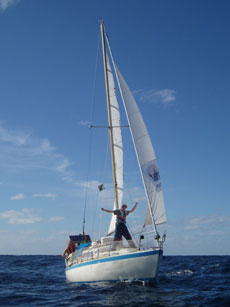 The Vega was designed by Per Brohall of Sweden in 1964, an experienced wooden boat designer who wanted to make sailing accessible to all, not only the wealthy elite upper crust of society. This was the 1960's, when plastic tecnhologies were under intensive development, and glass fibre, a cheap and very strong material, was perfected. Brohall decided that with a simple boat that carried a simple engine, yahting could become popular recreation in Scandanavia and beyond. He was determined to produce a large number of affordable sailboats with what he saw as a revolutionary new material. One important thing with the Vega was that there had to be enough room inside for a family, as Sweden´s economy was improving and families were looking for recreation. Most importantly, the Vega would need to be strong to withstand heavy use and navigational errors, so that accidents would not result in tragedy for the family on board. The Vega was designed by Per Brohall of Sweden in 1964, an experienced wooden boat designer who wanted to make sailing accessible to all, not only the wealthy elite upper crust of society. This was the 1960's, when plastic tecnhologies were under intensive development, and glass fibre, a cheap and very strong material, was perfected. Brohall decided that with a simple boat that carried a simple engine, yahting could become popular recreation in Scandanavia and beyond. He was determined to produce a large number of affordable sailboats with what he saw as a revolutionary new material. One important thing with the Vega was that there had to be enough room inside for a family, as Sweden´s economy was improving and families were looking for recreation. Most importantly, the Vega would need to be strong to withstand heavy use and navigational errors, so that accidents would not result in tragedy for the family on board.
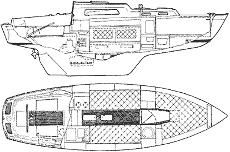 The Vega is the second-most produced boat in the history of Sweden, with 3,450 constructed, which shows that it was a hit design. The Vegas have sailed around the planet, and has made one well-known journey across the Southern Ocean to Antarctica, as featured in the documentary film Berserk, and to Svalbard Island in the Arctic Ocean. When the price of oil rose in the 1970s, and glass fibre technology was better understood, the hull was made thinner. The Sally Blue is one of the early Vegas, so it has one of the thickest hulls of any glass fibre boats in the world. The Vega is the second-most produced boat in the history of Sweden, with 3,450 constructed, which shows that it was a hit design. The Vegas have sailed around the planet, and has made one well-known journey across the Southern Ocean to Antarctica, as featured in the documentary film Berserk, and to Svalbard Island in the Arctic Ocean. When the price of oil rose in the 1970s, and glass fibre technology was better understood, the hull was made thinner. The Sally Blue is one of the early Vegas, so it has one of the thickest hulls of any glass fibre boats in the world. |
|
 |
 |
Exterior modifications:
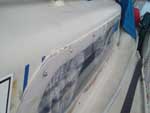 One weak point at the vega are the big windows. These were made even bigger in 5mm thick lexan and fastened to the outside of the boat, to ensure that they would be more resistant to caving in. One weak point at the vega are the big windows. These were made even bigger in 5mm thick lexan and fastened to the outside of the boat, to ensure that they would be more resistant to caving in.
With plenty of Sikaflex it was possible to make them waterproof. The windows are fastened whith 12 screws on each side going through deck.
Kajsa´s father built an adjustable metal solar panel platform. We installed nets above the gunwales to act as a fence, which was kept low in the stern to make it easier to wash dishes and to climb aboard from sea. 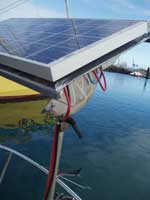 We also attempted to seal every leak on the deck, which required the removal of various non-essential fittings, such as the chimney from a heater that was taken out, and a ventilation fan from above where the toilet had been. Large bolts were sunken into the deck to secure the life raft, so the life raft will have to be sold with the boat. In the cockpit a new wooden floor was built to replace the damaged one that came with the boat. A new sail on a roll (which is very convenient for reefing) was added to relace a sail torn during the same heavey winds that broke the interior wall, and an improved reefing system of lines was created. We also attempted to seal every leak on the deck, which required the removal of various non-essential fittings, such as the chimney from a heater that was taken out, and a ventilation fan from above where the toilet had been. Large bolts were sunken into the deck to secure the life raft, so the life raft will have to be sold with the boat. In the cockpit a new wooden floor was built to replace the damaged one that came with the boat. A new sail on a roll (which is very convenient for reefing) was added to relace a sail torn during the same heavey winds that broke the interior wall, and an improved reefing system of lines was created.
All of the metal rigging (such as mast stays) were replaced as the old one had corroded. The new ones, although they are stainless steel, were already showing rust after just 100 days at sea.
Interior modifications
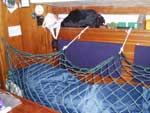 The boat hardly resembles what it was in the beginning. In the main cabin hanging net baskets were added, and nets were installed on the beds. The bed-nets were considered a priority after Kajsa was catapulted across the cabin during high seas early in the journey, which resulted in an large bruise on her thigh. The nets are designed to hold us securely on our beds. New shelves were built and the toilet was removed to create more storage space. We built a battery support platform so that the batteries would be secure in any weather. The boat hardly resembles what it was in the beginning. In the main cabin hanging net baskets were added, and nets were installed on the beds. The bed-nets were considered a priority after Kajsa was catapulted across the cabin during high seas early in the journey, which resulted in an large bruise on her thigh. The nets are designed to hold us securely on our beds. New shelves were built and the toilet was removed to create more storage space. We built a battery support platform so that the batteries would be secure in any weather.
The cabin interior was so mouldy and soot-covered that a black powder would stick to anything that touched it, but a coat of paint created a clean and bright ambience inside the ship. 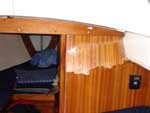 We reinforcd the mast foot, which is the area inside the boat that takes the downward pressure of the mast. During training just prior to the expedition, while sailing too hard with too much sail, the wall under the mast foot ruptured, so this needed to be replaced as well. To maintain organization and avoid injury from loose objects during rough weather, all storage areas were equipped with nets to secure their contents.We installed shock cords in place of pipes for the curtains. We reinforcd the mast foot, which is the area inside the boat that takes the downward pressure of the mast. During training just prior to the expedition, while sailing too hard with too much sail, the wall under the mast foot ruptured, so this needed to be replaced as well. To maintain organization and avoid injury from loose objects during rough weather, all storage areas were equipped with nets to secure their contents.We installed shock cords in place of pipes for the curtains.
Electrical system 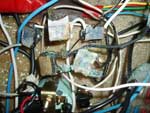 Many old things where worn out. Upgrades were made with 2,5mm2 cable. New switches inside the boat to decrese risk of corrosion. Many elecrtical outlets, the same as those used for car lighters, were installed to make electicity accessible. Many old things where worn out. Upgrades were made with 2,5mm2 cable. New switches inside the boat to decrese risk of corrosion. Many elecrtical outlets, the same as those used for car lighters, were installed to make electicity accessible.
Three batteries - one 70 Ah for emergency, and two 230Ah batteries, are charged by a 55W solar panel. The cabin is lit by low-consumption LED lights inside. A single navigational light with three colours reduces the need to power three bulbs. Big energy consumers are the computer, radio, headtorches and GPS. |
|
 |
 |
| Our philosophy is KISS: keep it simple, stupid. The more things on board, the more money you spend on repairs and extra equipment and the more time you spend on repairs and maintainance.
 Our navigational equipment includes a GPS, laptop loaded with charts, but also paper charts, which are large scale due to our small budget. It vital to have paper charts in case of a computer failure, but the digital charts are extremely detailed and accurate, so as long as the computer holds up we will use them primarily. There is a back-up computer for navigation, but also a new laptop that is a luxury that enables us to watch films on board. Our navigational equipment includes a GPS, laptop loaded with charts, but also paper charts, which are large scale due to our small budget. It vital to have paper charts in case of a computer failure, but the digital charts are extremely detailed and accurate, so as long as the computer holds up we will use them primarily. There is a back-up computer for navigation, but also a new laptop that is a luxury that enables us to watch films on board.
 We use a VHF radio for spoken comunication, a SSB radio to receive weather information, and short and middle wave radio for news and entertainment. We use a VHF radio for spoken comunication, a SSB radio to receive weather information, and short and middle wave radio for news and entertainment.
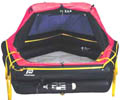 Our saftety equipment contains an EPIRB (), a liferaft and a grab-bag with additional supplies of water and food. Our saftety equipment contains an EPIRB (), a liferaft and a grab-bag with additional supplies of water and food. |
|
 |
 |
We have the smallest budget possible to carry out this journey. We all worked hard and saved for one year to make it possible to travel for two years. As a group, we aim to spend only an average of ten euros per day. That expenditure, plus our initial start-up costs, brings the budget to 20,000 euros, bringing the average to 30 euros per day. We hope to sell the boat upon our return to Sweden, in order to recoup some of the initial expenses.
According to our accounting, we think that this journey will be initial expendisture of 60,000 croners, or 6,000 euros per person. The budged breakdown is as follows.
The boat cost 6,000 euros but was not in especially good shape, which meant that each of us had to contribute another 2,000 euros that would be spent making the boat ready to sail offshore. We also contributed another 2,000 euros each into a joint expedition account from which food and essential group supplies are purchased. Each one of us keeps a personal account with about 2,000 euros, for personal purchases along the way.
Expedition Preparation Budget:
Income
1. Personal investment: 8,000.-
2. Sponsored 1,500.-
Total: 9500.-
Expenses, excluding daily food costs
1. Ropes: 250.-
2. Water tanks and hoses: 300.-
3. Electrical system: 1370.-
4. Construction material: 280.-
5. Pain and Resin: 400.-
6. Permits and essential literature: 190.-
7. Navigation equipment and supplies: 790.-
8. Communication equipment: 126.-
9. Spare parts: 130.-
10.Miscellaneous: 450.-
20.Rigging: 600.-
30.Medicine 50.-
40.Life boat: 1750.-
50.Rubber dingy: 700.-
60.Boat Insurance: 1000.-
Total Expenses: 9520.- (20 Euros over budget!)
We managed to stick to this budget while preparing and stocking the boat for the journey, but the question remains whether we will be able to keep our running costs low enough. If we run out of money, we will stop to work along the way. Some expenses are personal, such as medical insurance (600 Euros each), and any beverages beyond milk and juice. |
|
 |
|
|
Warning: include(position.php) [function.include]: failed to open stream: No such file or directory in /var/www/runtjorden.com/public_html/eng_projekt.php on line 393
Warning: include() [function.include]: Failed opening 'position.php' for inclusion (include_path='.') in /var/www/runtjorden.com/public_html/eng_projekt.php on line 393
|
|
|
|
